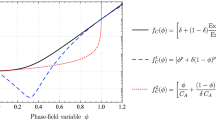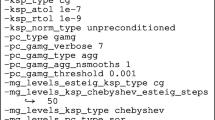Abstract
This paper is concerned with the topological optimization of elastic structures, with the goal of minimizing the compliance and/or mass of the structure, subject to a stress constraint. It is well known that depending upon the geometry and the loading conditions, the stress field can exhibit singularities, if these singularities are not adequately resolved, the topological optimization process will be ineffective. For computational efficiency, adaptive mesh refinement is required to adequately resolve the stress field. This poses a challenge for the traditional Solid Isotropic Material with Penalization (SIMP) method that employs a one-to-one correspondence between the finite element mesh and the optimization design variables because as the mesh is refined, the optimization process must somehow be re-started with a new set of design variables. The proposed solution is a dual mesh approach, one finite element mesh defines the material distribution, a second finite element mesh is used for the computation of the displacement and stress fields. This allows for stress-based adaptive mesh refinement without modifying the definition of the optimization design variables. A second benefit of this dual mesh approach is that there is no need to apply a filter to the design variables to enforce a length scale, instead the length scale is determined by the design mesh. This reduces the number of design variables and allows the designer to apply spatially varying length scale if desired. The efficacy of this dual mesh approach is established via several stress-constrained topology optimization problems.























Similar content being viewed by others
Notes
We introduce a lower bound, i.e., 𝜖 > 0, on the Berstein coefficients to avoid singularity in the analysis. However, this may ignore a globally optimal design as discussed in Cheng and Jiang (1992, 1997), Bruggi (2008), Le et al. (2010). We apply the relaxed stress indicator method to alleviate this issue as in Le et al. (2010).
References
Amrosio L, Buttazaro G (1993) An optimal-design problem with perimeter penalization. Calc Var 1(1):55–69
Amstutz S, Novotny A (2010) Topological optimization of structures subject to Von Mises stress constraints. Struct Multidisc Optim 41(3):407–420
Bendsoe M (1989) Optimal shape design as a material distribution problem. Struct Optim 1:193–202
Bendsoe M, Sigmund O (2003) Topology optimization theory, methods, and applications. Springer, Berlin
Biswas A, Shapiro V, Tsukanov I (2004) Heterogeneous material modeling with distance fields. Comp Aided Geom Des 21:215–232
Bourdin B (2001) Filters in topology optimization. Int J Num Meth Eng 50:2143–2158
Bruggi M (2008) On an alternative approach to stress constraints relaxation in topology optimization. Struct Multidiscip Optim 36(2):125–141
Bruggi M, Verani M (2011) A fully adaptive topology optimization algorithm with goal oriented error control. Comp Struct 89:1481–1493
Bruns T, Tortorelli D (2001) Topology optimization of nonlinear elastic structures and compliant mechanisms. Comput Methods Appl Mech Eng 190:26–27
Bruns T, Tortorelli D (2003) An element removal and reintroduction strategy for the topology optimization of structures and compliant mechanisms. Int J Numer Methods Eng 57(10):1413–1430
Chen J, Shapiro V (2008) Optimization of continuous heterogenous models. Heterogen Object Model Appl Lect Notes Comput Sci 4889:193–213
Cheng G, Jiang Z (1992) Study on topology optimization with stress constraints. Eng Optim 20(2):129–148
Cheng G, Guo X (1997) ε-relaxed approach in structural topology optimization. Struct Optim 13(4):258–266
Duysinx P, Bendsoe M (1998) Topology optimization of continuum structures with local stress constraints. Int J Numer Meth Eng 43:1453–1478
Frigo M, Johnson SG (2005) The design and implementation of fftw3. Proc IEEE 93(2):216–231
Gomes A, Suleman A (2006) Application of spectral level set methodology in topology optimization. Struct Multi Optim 31:430–443
Guest TBJK, Prevost JH (2004) Achieving minimum length scale in topology optimization using nodal design variables and projection functions. Int J Numer Meth Eng 61(2):238–254
Guest JK, Genut LCS (2010) Reducing dimensionality in topology optimization using adaptive design variable fields. Int J Numer Meth Eng 81(8):1019–1045
Guo X, Zhang W, Wang MY, Wei P (2011) Stress-related topology optimization via level set approach. Comput Methods Appl Mech Eng 200(47-48):3439–3452
Guo X, Zhang W, Zhong W (2014a) Doing topology optimization explicitly and geometrically-a new moving morphable components based framework. Journal Of Applied Mechanics-Transactions Of The ASME 81(8):081009
Guo X, Zhang W, Zhong W (2014b) Stress-related topology optimization of continuum structures involving multi-phase materials. Comput Methods Appl Mech Eng 268:632–655
Gupta DK, Langelaar M, van Keulen F (2018) Qr-patterns: artefacts in multiresolution topology optimization. Struct Multidiscip Optim 58(4):1335–1350
Haber R, Jog C, Bendsoe M (1996) A new approach to variable-topology shape design using a constraint on perimeter. Struct Optim 11(1):1–12
Jensen KE (2016) Solving stress and compliance constrained volume minimization using anisotropic mesh adaptation, the method of moving asymptotes, and a global p-norm. Struct Mult Optim 54:831–841
Kang Z, Wang Y (2011) Structural topology optimization based on non-local Shepard interpolation of density field. Comp Meth Appl Mech Eng 200(49-52):3515–3525
Kang Z, Wang YQ (2012) A nodal variable method of structural optimization based on shepard interpolant. Struct Mult Opt 90:329–342
Karp SN, Karal FC (1962) The elastic-field behavior in the neighborhood of a crack of arbitrary angle. Comm Pure Appl Math XV:413–421
Kim Y, Yoon G (2000) Multi-resolution multi-scale topology optimization - a new paradigm. Int J Solids Struct 37(39):5529–5559
Körner TW (1988) Fourier analysis. Cambridge University Press, Cambridge
Lazarov B, Sigmund O (2011) Filters in topology optimization based on helmholtz-type differential equations. Int J Numer Meth Eng 86:765–781
Le C, Norato J, Bruns T, Ha C, Tortorelli D (2010) Stress-based topology optimization for continua. Struct Multidisc Optim 41:605–620
Lieu QX, Lee J (2017) Multiresolution topology optimization using isogeometric analysis. Int J Numer Methods Eng 112(13):2025–2047
Liu C, Zhu Y, Sun Z, Li D, Du Z, Zhang W, Guo X (2018) An efficient moving morphable component (mmc)-based approach for multi-resolution topology optimization. Struct Multidiscip Optim 58(6):2455–2479
Luo Z, Zhang N, Wang Y, Gao W (2013) Topology optimization of structures using meshless density variable approximants. Int J Numer Meth Eng 93(4):443–464
Matsui K, Terada K (2004) Continuous approximation of material distribution for topology optimization. Int J Numer Meth Eng 59:1925–1944
Maute K, Ramm E (1995) Adaptive topology optimization. Struct Opt 10:100–112
MFEM (2019) Modular finite element methods, mfem.org
Nana A, Cuilliere JC, Francois V (2016) Towards adaptive topology optimization. Adv Eng Soft 100:290–307
Nguyen TH, Paulino GH, Song J, Le CH (2010) A computational paradigm for multiresolution topology optimization (mtop). Struct Multidiscip Optim 41(4):525–539
Nguyen TH, Le CH, Hajjar JF (2017) Topology optimization using the p-version of the finite element method. Struct Multidiscip Optim 56(3):571–586
Niordson F (1983) Optimal-design Of elastic plates with a constraint on the slope of the thickness function. Int J Solids Struct 19(2):141–151
Norato JA, Bell BK, Tortorelli DA (2015) A geometry projection method for continuum-based topology optimization with discrete elements. Comp Meth App Mech Eng 293:306–327
Panesar A, Brackett D, Ashcroft I, Wildman R, Hague R (2017) Hierarchical remeshing strategies with mesh mapping for topology optimization. Int J Numer Meth Eng 111:676–700
Picelli R, Townsend S, Brampton C, Norato J, Kim H (2018) Stress-based shape and topology optimization with the level set method. Comput Methods Appl Mech Eng 329:1–23
Poulsen T (2002) Topology optimization in wavelet space. Int J Numer Meth Eng 53:567–582
Qian X (2013) Topology optimization in b-spline space. Comp Meth Appl Mech Eng 265:15–35
Rahmatalla S, Swan C (2004) A Q4/Q4 continuum structural topology implementation. Struct Mult Optim 27:130–135
Rozvany G (2001) Aims, scope, methods, history, and unified terminology of computer aided optimization in structural mechanics. Struct Multidiscip Opt 21(2):90–108
Sigmund O, Petersson J (1998) Numerical instabilities in topology optimization: a survey on procedures dealing with checkerboards, mesh-dependencies and local minima. Struct Optim 16(1): 68–75
Salazar de Troya MA, Tortorelli D (2018) Adaptive mesh refinement in stress-constrained topology opotimization. Struct Mult Opt 58:2369–2386
Sayood K (2012) Introduction to data compression. Morgan Kaufmann
Sidmund O, Petersson J (1998) Numerical instabilities in topology optimization: a survey on procedures dealing with checkerboards, mesh-dependencies and local minima. Struct Optim 16:68–75
Suresh K, Takalloozadeh M (2013) Stress-constrained topology optimizatioin: a topilogical level-set approach. Struct Mult Optim 48:295–309
Wächter A, Biegler LT (2006) On the implementation of a primal-dual interior point filter line search algorithm for large-scale nonlinear programming. Math Program 106(1):5–57
Wang Y, Kang Z, He Q (2013) An adaptive refinement approach for topology optimization based on separated density field description. Comput Struct 117:10–22
Wang Y, Kang Z, He Q (2014) Adaptive topology optimization with independent error control for separated displacement and density fields. Comput Struct 135:50–61
Williams ML (1952) Stress singularities resulting from various boundary conditions in angular corners of plates in extension. J App Mech ASME 19(4):526–528
White DA, Stowell MS (2018) Topological optimization of structures using Fourier representations. Struct Multidisp Opt 58:1205–1220
Yang R, Chen C (1996) Stress-based topology optimization. Struct Optim 12:98–105
Yosibash Z (2012) Singularities in elliptic boundary value problems and elasticity and their connection with failure initiation. Springer, Berlin
Zhang S, Norato JA, Gain AL, Lyu N (2016) A geometry projection method for the topology optimization of plate structures. Struct Multidiscip Optim 54(5, SI):1173–1190
Zhang W, Liu Y, Weng P, Zhu Y, Guo X (2017) Explicit control of structural complexity in topology optimization. Comp Meth Appl Mech Engrg 324:149–169
Zhang W, Li D, Zhou J, Du Z, Li B, Guo X (2018) A moving morphable void (Mmv)-based explicit approach for topology optimization considering stress constraints. Comput Methods Appl Mech Eng 334:381–413
Author information
Authors and Affiliations
Corresponding author
Ethics declarations
Conflict of interest
The authors declare that they have no conflict of interest.
Additional information
Responsible Editor: Xu Guo
Publisher’s note
Springer Nature remains neutral with regard to jurisdictional claims in published maps and institutional affiliations.
Prepared by LLNL under Contract DE-AC52-07NA27344
Rights and permissions
About this article
Cite this article
White, D.A., Choi, Y. & Kudo, J. A dual mesh method with adaptivity for stress-constrained topology optimization. Struct Multidisc Optim 61, 749–762 (2020). https://doi.org/10.1007/s00158-019-02393-6
Received:
Revised:
Accepted:
Published:
Issue Date:
DOI: https://doi.org/10.1007/s00158-019-02393-6




